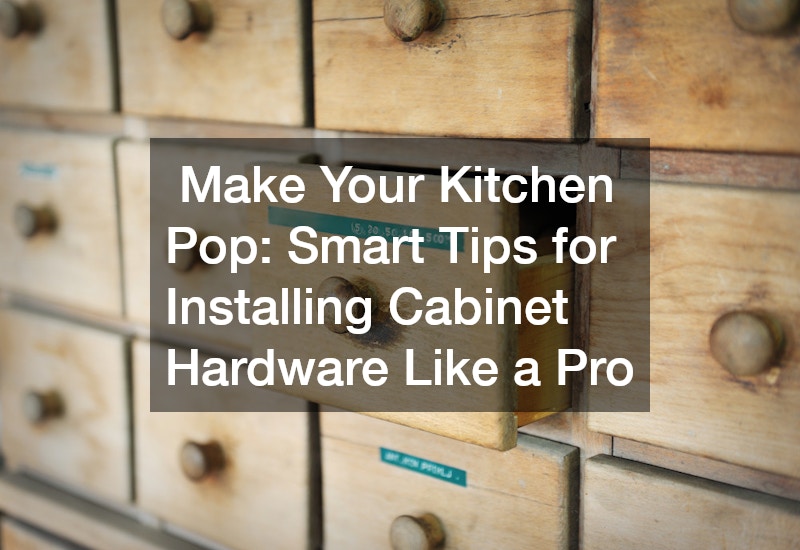Installing cabinet hardware is one of the easiest ways to refresh your kitchen or bathroom without taking on a major renovation. From knobs to pulls, these small pieces make a big visual impact—and the installation process is simple when you know what to do. Whether you’re doing a full makeover or just want to elevate your space, following the right steps can help you avoid misalignment, frustration, or re-drilling. Below are key tips to guide your cabinet hardware installation and ensure a polished finish.
Choose the Right Hardware for Your Space
Before you start measuring or drilling, choose cabinet hardware that complements your cabinets and overall design theme. Sleek, modern handles can give your kitchen a contemporary edge, while vintage-style knobs can add charm to a rustic or traditional layout.
Take into account the finish (brushed nickel, matte black, chrome, brass, etc.), shape, and size. It’s best to visit a cabinet hardware store to see and feel the options in person so you can match them properly with your cabinet material and room aesthetic.
If you’re replacing old hardware, try to match the new pieces to the existing hole spacing. If you’re installing brand-new cabinets or hardware for the first time, you have more flexibility in size and placement.
Gather the Right Tools and Supplies
To install cabinet hardware correctly, you’ll need a few essential tools:
-
A hardware jig or template (for accurate placement)
-
A measuring tape or ruler
-
A level
-
A pencil or marking tool
-
A drill with drill bits
-
A screwdriver (manual or electric)
Using a hardware jig is especially helpful because it ensures consistent placement across all doors and drawers. You can also use a homemade template from cardboard or wood if you prefer a DIY option.
Mark Carefully Before Drilling
Precision is key when it comes to cabinet hardware. Once you’ve selected your hardware and tools, it’s time to determine where the hardware should go.
For cabinet doors, knobs are usually placed 2½ to 3 inches from the bottom corner (upper cabinets) or top corner (lower cabinets), while pulls typically align vertically and are centered horizontally on the edge stile.
For drawers, center the hardware horizontally and vertically, unless you’re using two pulls for wide drawers. In that case, split the drawer into thirds and place each pull at the one-third and two-thirds mark for balance.
Before drilling, mark the locations lightly with a pencil. Then double-check each mark using your jig, level, and measuring tape to ensure everything is aligned and symmetrical.
Drill with Care
After confirming your measurements and markings, it’s time to drill pilot holes. Start with a small drill bit (typically 3/32-inch) to avoid splintering the wood. Drill straight and steady—applying too much pressure or using a dull bit could damage the surface.
Once the pilot holes are done, test fit the hardware to make sure it aligns with the holes properly. If everything looks good, proceed to drill the final holes using the appropriate bit size for your hardware screws.
Remember: it’s always better to drill cautiously and go slowly than to rush and risk misaligned or uneven hardware.
Secure the Hardware and Inspect
With holes drilled, install the hardware using a screwdriver or drill. Avoid over-tightening the screws—this could strip the wood or damage the cabinet face. Once all pieces are in place, step back and inspect the results.
Open and close the doors and drawers to check for proper clearance. Ensure that handles don’t knock against each other and that every piece is aligned evenly. If you notice any slight shifts, now is the time to make adjustments.
Add Finishing Touches
Once all hardware is securely in place, wipe down your cabinets to remove any pencil marks, wood dust, or smudges. This final cleaning step helps the new hardware shine and gives your space a clean, refreshed look.
If you’re planning to change other aspects of the kitchen—like backsplash, countertops, or lighting—installing your cabinet hardware first can help guide those design choices.
Pro Tips for a Seamless Installation
-
Use a cabinet hardware jig for perfectly aligned holes every time.
-
Label your cabinets and drawers before removing them to avoid mixing them up.
-
Measure twice, drill once. Mistakes with holes are difficult and often impossible to fix without replacing the cabinet face.
-
Test with tape. Temporarily tape hardware pieces in place to see how they’ll look before committing to a location.
-
Visit a trusted cabinet hardware store to explore options and get expert advice on size, finish, and installation tools.
Installing cabinet hardware may seem like a small upgrade, but it plays a major role in the overall look and feel of your space. With the right tools, careful planning, and a steady hand, you can give your kitchen or bathroom a polished, cohesive appearance in just a few hours. Whether you’re doing it yourself or working with a contractor, these tips will help ensure every knob and pull looks perfectly placed.
For top-quality hardware and expert guidance, stop by your local cabinet hardware store. Having professionals walk you through your options can help you avoid common pitfalls and find the perfect finish for your cabinets.






